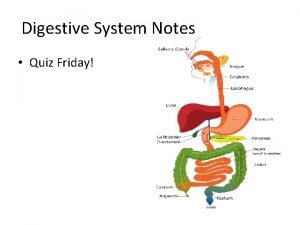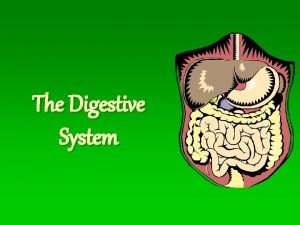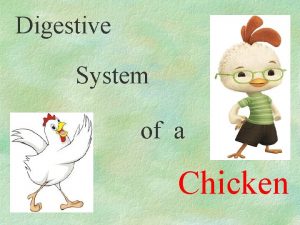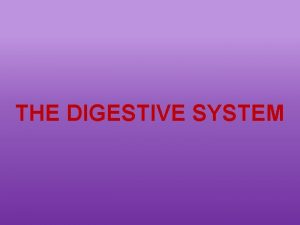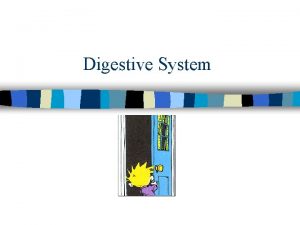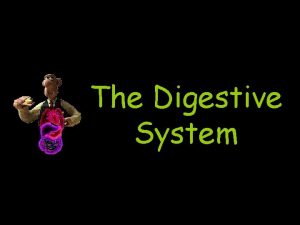Digestive System The digestive system has two main















- Slides: 15

Digestive System

The digestive system has two main functions: 1. to convert food into nutrients your body needs, and to rid the body of waste. 2. To do its job, the system requires the cooperation of a number of different organs throughout the body, including the mouth, stomach, intestines, liver and gallbladder

Hey there!! Here are 10 Fun Facts +1!! • • 1. An adult esophagus ranges from 10 to 14 inches in length, and 1 inch in diameter. • 2. We make 1 to 3 pints of saliva a day. • 3. Muscles contract in waves to move the food down the oesophagus. This means that food would get to a person's stomach, even if they were standing on their head • 4. It takes your mouth, esophagus, stomach, small intestine, large intestine, gallbladder, pancreas and liver just to digest a glass of milk. . • 5. An adults stomach can hold approximately 1. 5 liters of material. • 6. The average male will eat about 50 tons of food during his lifetime in order to sustain a weight of 150 pounds. • 7. Within the colon, a typical person harbors more than 400 distinct species of bacteria • 8. The liver is the largest organ in the body and performs more than 500 functions. • 9. The small intestine (pronounced in-test-in) is a long tube about 1 and a half to 2 inches around, and about 22 feet long. • 10. A full grown horse? ? Their coiled up intestines are 89 feet long. • 11. Food stays in your stomach for 2 to 3 hours. • https: //sites. google. com/site/digestivesystem 3051/fun-facts-2

Digestive System Overview • The major parts of the digestive system: • Salivary glands/Tongue-no hair on the tongue! • Pharynx • Epiglottis • Esophagus • Stomach • Small Intestine • Large Intestine • Rectum • Anus • Accessory digestive organs: liver, gallbladder, pancreas

Esophagus • From pharynx to stomach: • Salivary glands release mucus for lubrication, antimicrobial agents, and amylase to digest starch. • Epiglottis covers respiratory tract during swallowing • At end of esophagus is the lower esophageal sphincter (LES) • Propulsion of food occurs through peristalsis: • Contraction occurs behind the bolus of food and relaxation occurs ahead of the bolus of food

Stomach Functions: • store food • initiate digestion of proteins-peptoids • kill bacteria with the strong acidity (low p. H of the gastric juice) HCL • make chyme • material passed from the stomach to the small intestine is called the chyme.

Small Intestine • Small intestine is from the pyloric sphincter to the ileocecal valve • 21 ft in length, small in diameter compared to large intestine Regions of the small intestine: • duodenum: absoprtion of carbohydrates, lipids, amino acids, Ca 2+, iron • jejuneum: absopriton of carbohydrates, lipids, amino acids, Ca 2+, iron • ileum: absorption of bile salts, vitamin B 12, water electrolytes. • Villi/ microvilli: increases surface area for absorption • Core of villus: • blood capillaries: absorption of monosaccharides, amino acids • lymphatic vessels (central lacteal): absorption of fats

Large Intestine • Large intestine is from the ileocecal valve to the anus • Parts of the large intestine: ascending colon, transverse colon, descending colon, sigmoid colon, rectum, anal canal • contains no villi • involved in absorption of water, electrolytes, vitamins. • Contains bacteria E-Coli which serve a number of functions • absorption of vitamins (B and K) • produce small fatty acids used as energy by GI epithelial cells • help breakdown indigestible molecules • final water content of feces is about 200 ml

Liver • Major functions: • • • Production and secretion of bile-breaks down fats Detoxication of blood-toxins Secretion and storage of glucose Production of albumin Stores fat soluble vitamins-A, D, K, E • Liver clears substances via the bile duct in a similar manner to the way the kidney clears substances into the nephron. Gall bladder-looks like a thumb • Gallbladder stores bile.

PANCREAS • Pancreatic juice contains: • Produces insulin-controls blood sugar level • water: H 2 O • bicarbonate: HCO 3 • amylase: digests starch • trypsin: digests protein • lipase: digests fatty acids


Disorders: • Crohn’s Disease • Causes: unknown • Chronic inflammation bowel disease (IBD) • Effects especially the last part of the small intestine, but can affect from mouth to anus area. • Age 15 -35 700, 00 people in US • Symptoms: Diagnosis: • Abdominal pain blood test • Diarrhea stool test • Fever video capsule endoscopy • Weight loss barium x-ray • Vomiting Treatment: Diet/Medication Humira

Disorders • Gastritis-inflammation of the stomach • Hemorrhoids-inflammation of the rectum and or anus area-blood vessels. • Hernia-intestine protrudes through the abdominal wall • Ulcers-bacteria breaking down the mucin layer in the stomach exposing the inner layer-mucosa layer of the stomach. • Hepatitis-viral infections of the liver B & C • Diarrhea-liquid state of waste-feces • Constipation-solid state of the waste-feces • Acid Reflux-value at the end of the esophagus-back wash into the esophagus.

Celiac Disease • Disorder to the digestive tract caused by the autoimmune system disorder • Gluten sensitivity-protein found in wheat, rye, barley • Symptoms: • Gas • Bloating • Cramps • Diarrhea • Common foods: • Pasta’s, breads, crackers, seasonings, spices and some fried foods. • No cure! • Treatment: Diet/Fruits vegetables, seeds, fish, dairy products • Diagnosis: Blood test for antibodies

http: //www. nationalgeographic. com/science/healthand-human-body/digestive-system/ • Explanation of the digestive system
 A sentence has two main parts
A sentence has two main parts Pathway of food
Pathway of food Major function of digestive system
Major function of digestive system What is the main goal of the digestive system
What is the main goal of the digestive system Respiratory system circulatory system digestive system
Respiratory system circulatory system digestive system Future i will
Future i will Stated main idea
Stated main idea Void main int main
Void main int main Hình ảnh bộ gõ cơ thể búng tay
Hình ảnh bộ gõ cơ thể búng tay Ng-html
Ng-html Bổ thể
Bổ thể Tỉ lệ cơ thể trẻ em
Tỉ lệ cơ thể trẻ em Gấu đi như thế nào
Gấu đi như thế nào Thang điểm glasgow
Thang điểm glasgow Alleluia hat len nguoi oi
Alleluia hat len nguoi oi Môn thể thao bắt đầu bằng từ đua
Môn thể thao bắt đầu bằng từ đua

